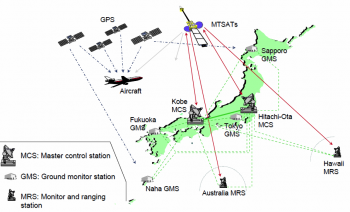If you wish to contribute or participate in the discussions about articles you are invited to contact the Editor
MSAS Architecture
| MSAS | |
|---|---|
| Title | MSAS Architecture |
| Author(s) | GMV. |
| Level | Basic |
| Year of Publication | 2011 |
The Multi-functional Satellite Augmentation System (MSAS) is the Japanese SBAS System: a GPS Augmentation system with the goal of improving its accuracy, integrity, and availability, and that uses the Multifunctional Transport Satellites (MTSAT) owned and operated by the Japanese Ministry of Land, Infrastructure and Transport and the Japan Meteorological Agency (JMA). Tests during Initial Operational Phase were accomplished successfully, and MSAS for aviation use was declared operational on September 27, 2007.[1]
MSAS Architecture
GPS signals are received at the MSAS Ground Monitor Stations and MSAS Monitor & Ranging Stations. These stations check operational status of GPS, and transmit GPS data to Master Control Stations that analyze GPS error and ionospheric delay. Then, these Master stations compute Augmentation information and broadcast it to GEO MTSAT (Multi-functional Transport Satellite)[2] satellites. Those satellites, MTSAT, rebroadcast the correction messages back to Earth, where MSAS-enabled GPS receivers use the MSAS corrections to compute a reliable and accurate position.
The main layers of MSAS architecture are:[3]
- MSAS Ground Segment: The ground segment is composed of four Ground Monitor Station (GMS) that collect information on the GPS and MTSAT signals. Then, the GMS send their data to two Master Control Station (MCS) in Kobe and Hitachiota, that compute precise differential corrections and integrity bounds and send them to the MTSAT satellites for rebroadcast to the User Segment. The MSAS Ground Segment is completed with two Monitor and Ranging Station (MRS), whose purpose is primarily the correct orbit determination of the MTSAT satellites.
- MSAS Space Segment: The space segment consists of two geosynchronous satellites (GEO): the Multifunctional Transport Satellites (MTSAT). These satellites are used also for weather/meteorological purposes. Their navigation payloads are in charge of broadcasting the correction messages generated by the Master Stations for reception by the User segment.
- MSAS User Segment: The user segment is the GPS and SBAS-enabled receiver, which uses the information broadcast from each GPS satellite to determine its location and the current time, and receives the MSAS corrections from the Space segment.

